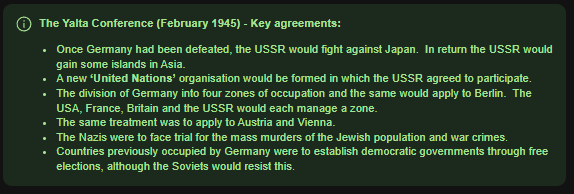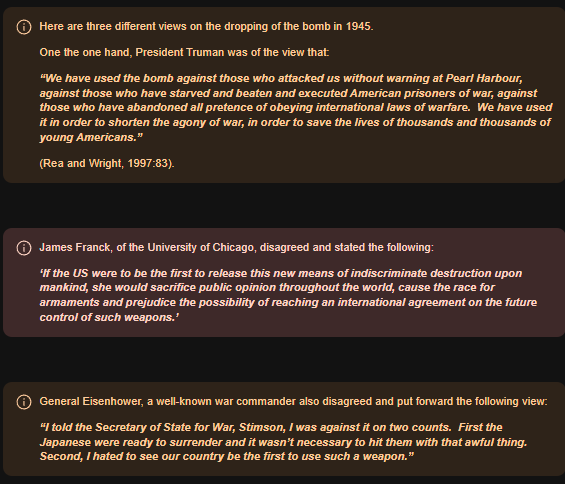The end of world war 2 (1945)
Between them, the countries of Britain, France, the USSR (also known as the Soviet Union) and the United States of America ultimately defeated Germany, Italy and Japan between 1939 and 1945. As with World War One the leaders of the victorious countries met to make the peace arrangements. In 1945 they were the so-called ‘Big Three’ or ‘Grand Alliance’, namely the USA’s President Franklin Roosevelt, British Prime Minister Winston Churchill and Soviet Leader Joseph Stalin. The first meeting was held at Tehran in Iran in 1943, and the second took place in Yalta in February in the Soviet Union. At the time of both of these conferences the fighting had not yet stopped. Despite this, some agreements were reached at Yalta in particular, mainly due to the fact that ‘all Europe lay at the mercy of the three powers which had successfully and decisively defeated Germany’.

The Beginning of Post-War Tensions
Tensions had emerged from an early stage of the war between the Soviets and the USA, with Stalin anxious for assistance in dealing with the German threat. This had been a key demand of his at the Teheran Conference of 1943 in particular. The failure of the British and Americans to established a ‘second front’ in Western Europe until June 1944 (D-Day) significantly alarmed Stalin, who felt that the Soviets were taking the bulk of the wartime casualties on the Eastern Front. This was evident in the fact that by the time the war was over, the Soviet Union has suffered an estimated 20-25 million casualties (both military and civilian), and the USA had suffered only half a million by comparison.
World War Two finally came to an official end with the defeat of Japan in August 1945. By that time Truman had replaced Roosevelt as President of the United States of America, and Churchill had been replaced by Attlee in Britain. The defeat of Japan was achieved rapidly with the use of the only recently developed atomic bomb (see aftermath above left). Authorised by Truman, two bombs were dropped, the first on Hiroshima and the second on Nagasaki. Between them they killed up to 200,000 people, some instantly, the remainder dying of burns. Prior to this in July, a second major post-war conference was held at Potsdam (in Germany). The dropping of the first atomic bomb known to mankind was extremely controversial and sparked many diverse views, particularly from Americans. It also generated extra suspicion within the Soviet Union (now the USA’s main rival as a superpower) about American post-war intentions.

From these three differing views, it is possible to see that the moral responsibility for releasing the atomic bomb was keenly felt by those involved. It should also be noted that the presence of such military weapons would play a major role within the Cold War, both as a source of constant threat and as a ‘deterrent’. American use of this bomb was swiftly followed by the Soviets gaining the capacity to use such weapons within just a few years, and many have seen this as one of the key early developments of the emerging Cold War.
The Potsdam Conference
The third major conference between the dominant and victorious powers took place at Potsdam in July 1945, a month or so before the atomic bombs were dropped on the Japanese. Germany had been defeated and it was therefore time to conclude the territorial organisation of Europe. Of the original ‘Big Three’ only Stalin remained, as Clement Atlee had replaced Churchill and Truman had replaced Roosevelt. As a consequence of the war, Soviet troops were now in control of the bulk of Eastern Europe, and Stalin’s armies occupied Poland, Czechoslovakia, Hungry, Romania, Bulgaria, Lithuania, Latvia, Estonia and Finland. After the war the USA and Britain had intended each of these countries to hold free elections in the hope of establishing democratic governments and a system of free enterprise within each. However, Soviet control of many of these countries made this very unlikely.
During the conference Truman (left), was informed that the atomic bomb was ready to be used. This had the effect of reducing the United States dependence on the USSR for help in defeating the Japanese. With the common enemy – Japan – about to be taken out of the equation, the need for unity disappeared. The USSR subsequently slipped back into her pre-war isolation based on the fact that Communism was regarded as a threat to capitalism. From Stalin’s perspective, the Eastern European countries therefore provided the Soviet Union with a belt of protection from invasion by the countries west of Russia, and he was therefore reluctant to allow them to become liberal democracies or to remove his armies. This increased the existing suspicion and distrust felt by the United States and Britain towards the USSR/Soviet Union, and for his part Truman felt that a tough line had to be taken to deal with possible Soviet expansion across Europe.

The USSR acquired a fair amount of territory, and although the American President and the British Prime Minister were concerned, they had little choice with Soviet troops actually occupying the territory in question. Thereafter, under the influence of Stalin, communist governments were set up in each of the Eastern European countries. Yugoslavia and Albania, however, set up Communist style governments independent of the influence of the USSR.
